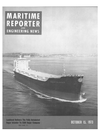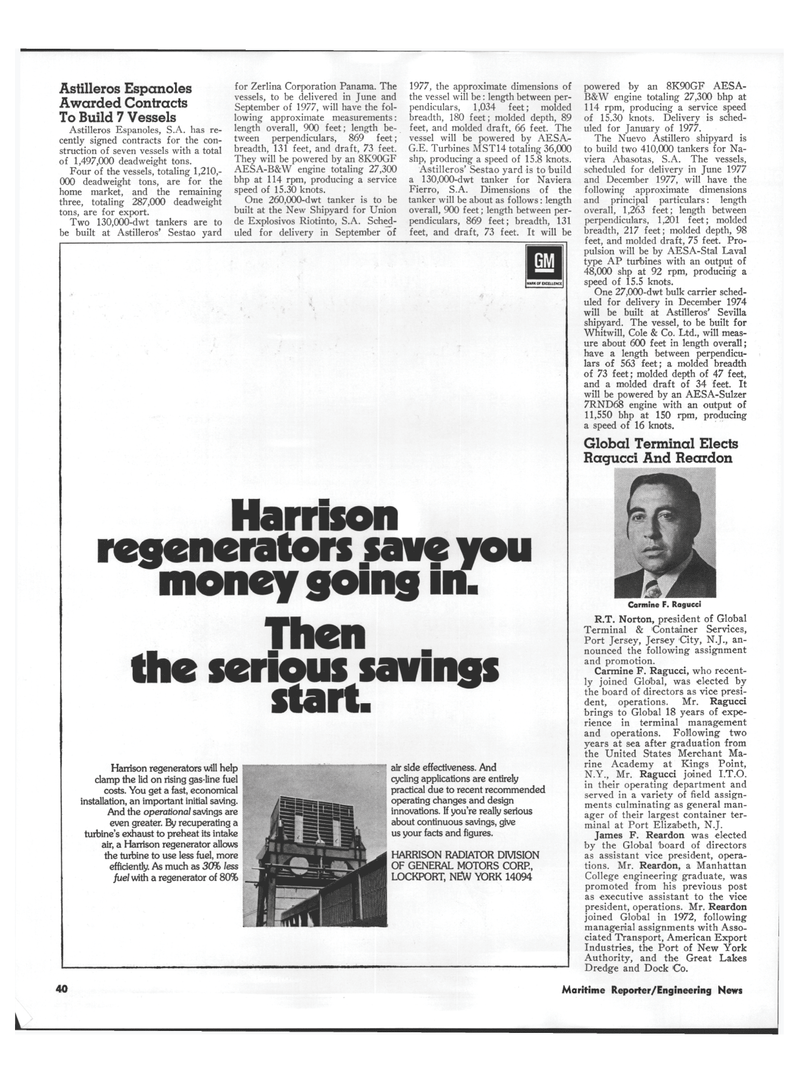
Page 30: of Maritime Reporter Magazine (October 15, 1973)
Read this page in Pdf, Flash or Html5 edition of October 15, 1973 Maritime Reporter Magazine
Astilleros Espanoles
Awarded Contracts
To Build 7 Vessels
Astilleros Espanoles, S.A. has re- cently signed contracts for the con- struction of seven vessels with a total of 1,497,000 deadweight tons.
Four of the vessels, totaling 1,210,- 000 deadweight tons, are for the home market, and the remaining three, totaling 287,000 deadweight tons, are for export.
Two 130,000-dwt tankers are to be built at Astilleros' Sestao yard for Zerlina Corporation Panama. The vessels, to be delivered in June and
September of 1977, will have the fol- lowing approximate measurements: length overall, 900 feet; length be- tween perpendiculars, 869 feet; breadth, 131 feet, and draft, 73 feet.
They will be powered by an 8K90GF
AESA-B&W engine totaling 27,300 bhp at 114 rpm, producing a service speed of 15.30 knots.
One 260,000-dwt tanker is to be built at the New Shipyard for Union de Explosivos Riotinto, S.A. Sched- uled for delivery in September of 1977, the approximate dimensions of the vessel will be: length between per- pendiculars, 1,034 feet; molded breadth, 180 feet; molded depth, 89 feet, and molded draft, 66 feet. The vessel will be powered by AESA-
G.E. Turbines MST14 totaling 36,000 shp, producing a speed of 15.8 knots.
Astilleros' Sestao yard is to build a 130,000-dwt tanker for Naviera
Fierro, S.A. Dimensions of the tanker will be about as follows: length overall, 900 feet; length between per- pendiculars, 869 feet; breadth, 131 feet, and draft, 73 feet. It will be powered by an 8K90GF AESA-
B&W engine totaling 27,300 bhp at 114 rpm, producing a service speed of 15.30 knots. Delivery is sched- uled for January of 1977.
The Nuevo Astillero shipyard is to build two 410,000 tankers for Na- viera Abasotas, S.A. The vessels, scheduled for delivery in June 1977 and December 1977, will have the following approximate dimensions and principal particulars: length overall, 1,263 feet; length between perpendiculars, 1,201 feet; molded breadth, 217 feet; molded depth, 98 feet, and molded draft, 75 feet. Pro- pulsion will be by AESA-Stal Laval type AP turbines with an output of 48,000 shp at 92 rpm, producing a speed of 15.5 knots.
One 27,000-dwt bulk carrier sched- uled for delivery in December 1974 will be built at Astilleros' Sevilla shipyard. The vessel, to be built for
Whitwill, Cole & Co. Ltd., will meas- ure about 600 feet in length overall; have a length between perpendicu- lars of 563 feet; a molded breadth of 73 feet; molded depth of 47 feet, and a molded draft of 34 feet. It will be powered by an AESA-Sulzer 7RND68 engine with an output of 11,550 bhp at 150 rpm, producing a speed of 16 knots.
Global Terminal Elects
Ragucci And Reardon
Carmine F. Ragucci
R.T. Norton, president of Global
Terminal & 'Container Services,
Port Jersey, Jersey City, N.J., an- nounced the following assignment and promotion.
Carmine F. Ragucci, who recent- ly joined Global, was elected by the board of directors as vice presi- dent, operations. Mr. Ragucci brings to Global 18 years of expe- rience in terminal management and operations. Following two years at sea after graduation from the United States Merchant Ma- rine Academy at Kings Point,
N.Y., Mr. Ragucci joined I.T.O. in their operating department and served in a variety of field assign- ments culminating as general man- ager of their largest container ter- minal at Port Elizabeth, N.J.
James F. Reardon was elected by the Global board of directors as assistant vice president, opera- tions. Mr. Reardon, a Manhattan
College engineering graduate, was promoted from his previous post as executive assistant to the vice president, operations. Mr. Reardon joined Global in 1972, following managerial assignments with Asso- ciated Transport, American Export
Industries, the Port of New York
Authority, and the Great Lakes
Dredge and Dock 'Co.
WW Of EXCELLENCE
Harrison regenerators save you money going in.
Then the serious savings start.
Harrison regenerators will help clamp the lid on rising gas-line fuel costs. You get a fast, economical installation, an important initial saving.
And the operational savings are even greater. By recuperating a turbine's exhaust to preheat its intake air, a Harrison regenerator allows the turbine to use less fuel, more efficiently. As much as 30% less fuel with a regenerator of 80% air side effectiveness. And cycling applications are entirely practical due to recent recommended operating changes and design innovations. If you're really serious about continuous savings, give us your facts and figures.
HARRISON RADIATOR DIVISION
OF GENERAL MOTORS CORP.,
LOCKPORT, N^ YORK 14094 14
Maritime Reporter/Engineering News

 29
29

 31
31
